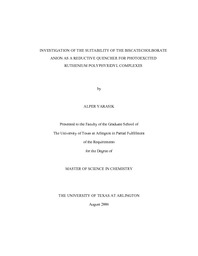| dc.description.abstract | Ruthenium polypyridyl complexes [Ru(L-L)3]2+, (L-L = 1,10 - phenanthroline or 2,2'- bipyridine) which covalently linked to electron donor or acceptor units are frequently used in artificial photosystems because of their high emission quantum yields, long excited-state lifetimes, favorable redox properties and excellent chemical stability. The ruthenium dimer P, [(phen)2Ru(tatpp)Ru(phen)2][PF6]4, undergoes multiple photoreductions in the presence of donors such as triethylamine (TEA); however, large amount of donors (0.3 M) are required for efficient reductions. This explores the use of a anionic donor such as [B(cat)2]- with the hypothesis that ion-pairing will result in lower required concentration of the donor. Electrochemical data reveals that [B(cat)2]- is oxidized irreversibly which suggests its application as a sacrificial donor. Stern- Volmer quenching of [B(cat)2]- with [Ru(bpy)3]2+ and photochemistry with complex P conducted to examine its usefulness for this application.
Replacement of the bridging ligand of photoactive Ru complex P4+ (tatpp for
9,11,20,22-Tetraazatetrapyrido[3,2-a: 2’, 3’-c:3’’, 2’’- l: 2’’’, 3’’’-n]pentacene) with
bdppz (for 1,19-dipyrido[3,2-a:29,39-c]phenazin-1,19-yldipyrido[3,2-a:29,39-c]-
phenazine) results in interesting electronic and redox properties. The first and second
reduction potentials of the resultant complex ([(phen)2Ru(dppz)-(dppz)Ru(phen)2]4+,
14+) are reported by De Cola and coworkers34. The cyclic voltammetry data revealed
two sequential one electron reductions and interestingly both first and second reduction
potentials (BD/BD- = -0.683 and BD-/BD2- = -0.873 vs NHE) are more negative than the
ruthenium complex P4+ (P4+/P3+ = -0.02 and P3+/P2+ = -0.513 vs NHE). Thus, the
species are more reductive which could be used in another application such as photosplitting
water. | en_US |

